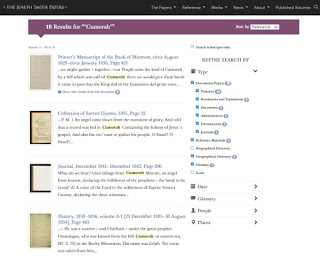This post is an example of my notes that I’m sharing because people ask these questions and now I can refer them to this blog.
I’ve mentioned before the “quirk” in the Joseph Smith Papers search engine that omits references to Cumorah. Other results are obscured by the formatting of the search results, which buries many of the results in a sublink. Consequently, you’ll miss the important references to Cumorah unless you know enough to dig a little deeper.
This is problematic because I still meet people who have no idea about these references to Cumorah, and if they go to the Joseph Smith Papers to search for them, they are difficult to find and/or not even present in the search results.
_____
Go to https://www.josephsmithpapers.org/.
In the search box, type “Cumorah,” with or without the quotation marks. You’ll get 18 results, depending on which types of documents you click on the right. (click to enlarge).
1.* Printer’s manuscript.
2. 1835 Hymns.
3. D&C 128. (Five versions, ##3, 6, 8, 11 and 12)
4. Zelph account.
5.* Book of Mormon 1837.
6.* Orson Pratt’s Interesting Account.
7.* Lucy Mack Smith, p. 1, bk 6 [click on link to get p. 11, bk. 3]
8.* History, 1834-1836, p. 101 (Letter VIII) [click on link to get
9. Corrill, History of the Church.
10. Blessing from Oliver Cowdery.
11. Introduction to Documents.
12. Gold plates reference.
13. Manchester Township reference.
14. I Had Seen a Vision transcript.
* Results marked with (*) have reduced font sublinks that say “Show only results from this document.”
I’m sure there is a legitimate reason for this structure, but it makes the search results incomplete and unwieldy, even misleading.
Unless you know exactly where to look for what you’re looking for, you won’t get the important Cumorah references in the first-level results and you can’t tell which of these sublinks to click on to find them. Going through each of the sublinks takes a lot of time.
The sublink architecture omits from the first-level results both Letter VII and Lucy’s account of Moroni’s first visit to Joseph Smith in which Moroni identified the hill as Cumorah. The reader has to know which sublink to click on to find these references.
Ordinary readers could easily conclude that these references to Cumorah don’t exist in the Joseph Smith Papers.
It’s also interesting that while the Joseph Smith Papers often leads people to articles in the Times and Seasons, it omits Letter VII and the other Oliver Cowdery letters that were published in the Times and Seasons, even though Joseph helped write them and his brothers Don Carlos and William each republished them. That’s important context for the presence of these letters in Joseph’s own History, 1834-1836.
The republication of these letters by Don Carlos in the 1841 Times and Seasons (at Joseph’s direction), is especially significant to understanding the reference to Cumorah in Joseph’s 1842 letter first published in the Times and Seasons that later became D&C 128. In other words, D&C 128:20 did not appear randomly or in a vacuum. It alluded to the history that was well known to readers of the Times and Seasons because they had read Letter VII just the year before in the same newspaper. By omitting all of this context, the Joseph Smith Papers does a disservice to readers.
Plus, as we’ve seen, these search results still omit the important reference to Cumorah in Lucy Mack Smith’s 1845 history that was also inexplicably omitted from the Saints book, volume 1.
“Stop, father, Stop.” said Joseph, “it was the angel of the Lord— as I passed by the hill of Cumorah, where the plates are, the angel of the Lord met me and said, that I had not been engaged enough in the work of the Lord;
https://www.josephsmithpapers.org/paper-summary/lucy-mack-smith-history-1845/111
_____
Now, open a new tab and go to https://www.josephsmithpapers.org/ again. This time, search for “Camorah,” with an “a” instead of a “u.” This is how it was spelled in the printer’s manuscript and the 1830 edition. You’ll get 4 results.
2. Printer’s Manuscript.
3. John Corrill, History of the Church (noting the hill was “anciently called Camorah”).
4. History, 1834-1836 (Letter VII).
You can see in the fourth item that the search engine hits on “Camorah” in Letter VII, but when you searched for Cumorah, it did not pick up “Cumorah” (circled in red below) in the first level results even though the words are on the same line. You only get this search result if you know enough to click on the sublink under History, 1834-1836, when you search for “Cumorah.”.
You can see this again by doing a search for “great struggle.” You’ll get two hits.
If you click on the first link, it takes you to the page in Joseph Smith’s history that relates the Zelph account.
Here’s a link to a .pdf facsimile of the original Times and Seasons (scroll to page 309).
Look again at the page from JS History 1838-1856.
They refer to the place where the plates were buried as “what is now known as the Hill Cumorah.”
Source: Letter VII
